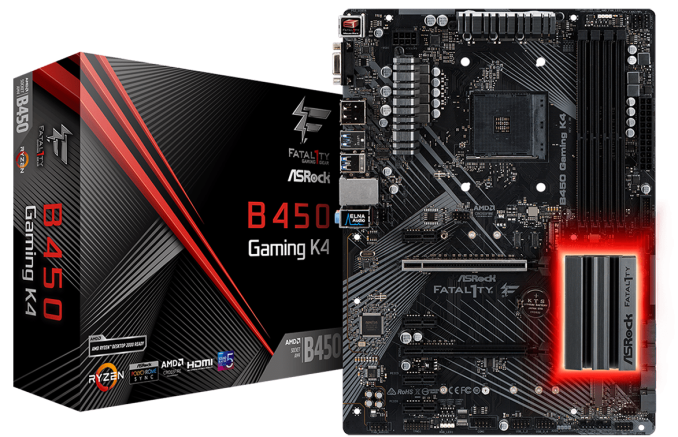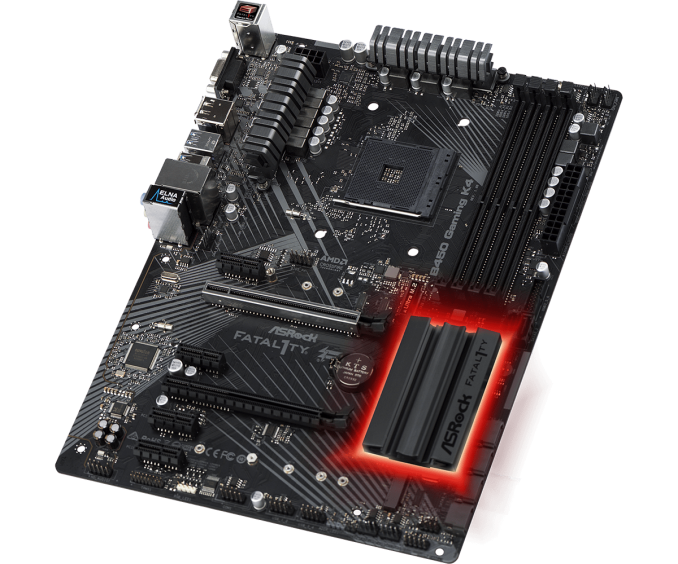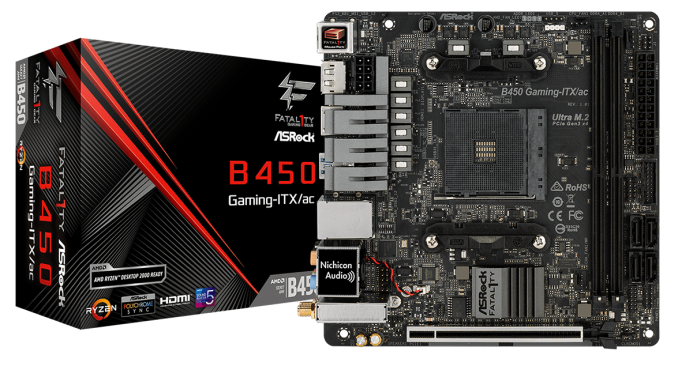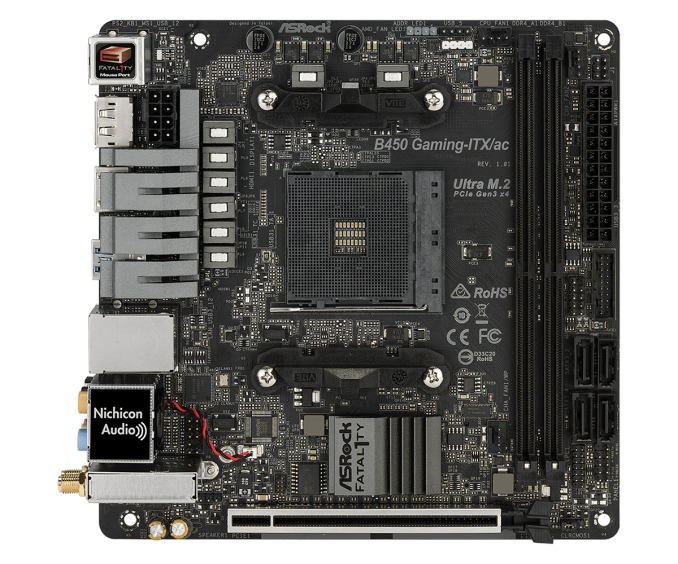The ASRock B450 Gaming ITX/ac and B450 Gaming K4 Motherboard Reviews
by Gavin Bonshor on July 31, 2018 10:00 AM ESTASRock B450 Gaming K4 Conclusion
The ASRock B450 Gaming K4 is an ATX sized motherboard gaming focused motherboard from the gaming branded range of products and like most budget fixated boards, has its strong and weak points. The B450 Gaming K4 is also the direct successor of the AB350 Gaming K4 which we previously reviewed and while the newer B450 alternative features a similar layout, the overall aesthetics are profoundly subtle. The B450 offering drops the red metallic heatsinks and replaces them with a dark grey which when combined with the integrated RGB LEDs in the chipset heatsink, offers a look which clashes less; red heatsinks without red LEDs look lost and numerous vendors have made this mistake in the past.
There is one notable improvement visually going from the AB350 Gaming K4 to the newer B450 Gaming K4 as the newer B450 model includes an RGB LED under the chipset heatsink which is compatible with ASRock’s Polychrome RGB Sync software. Everything else appears to be the same including the use of wallet conscious the Realtek ALC892 audio codec and Realtek based RTL8111 networking controller; the B450 Gaming K4 features a slightly newer RTL8111H, but the specifications between this and the RTL8111G remain the same.
While the capabilities stretch from the Ryzen desktop range of processors including the older first-generation chips, the ASRock B450 Gaming K4 also supports Ryzen’s Vega infused APUs, with a selection of video outputs consisting of an HDMI, a DisplayPort and a legacy D-Sub connector. The USB connectivity is improved upon over the last iteration with a pair of USB 3.1 10 Gbps ports; a Type-A and Type-C. Also featured is a total of four USB 3.1 5 Gbps Type-A ports and an additional two USB 2.0 ports. A further four USB 3.1 5 Gbps ports and two USB 2.0 can be made available through the use of onboard front panel headers. The three 3.5mm audio jacks are powered by the Realtek ALC892 audio codec and the LAN port controlled by a Realtek 8111H Gigabit networking chip.
The power delivery on the B450 Gaming K4 is very puzzling indeed with what looks like a 6+3 phase configuration actually running at a much lower spec 3+3. The Intersil ISL95712 PWM controller is only capable of running a maximum of seven channels; four for the CPU and three for the SoC. While the SoC section features three individual NIKOS PZ0903BK low side MOSFETs, each one features two NIKOS PK618B high side MOSFETs which are shorted together. The CPU section also features three pairs of the same MOSFETs which does give off the impression the B450 Gaming K4 is running six for the CPU, but in reality, they are doubled upon so while technically there is a 6+3 phase count there, ASRock’s marketing is somewhat misleading.
Storage options include a total of six SATA ports with two featuring straight angled connectors, with the remaining four laid out in a horizontal array to the side of the chipset heatsink. A single M.2 offers users the ability to utilize NVMe capable M.2 2280 SSDs running at PCIe 3.0 x4, whereas the second slot allows for M.2 22110 drives to be installed which runs at a maximum of PCIe 3.0 x2. This secondary M.2 slot does also support SATA drives, but shares bandwidth between the most southernly located two SATA 6 Gbps ports. The B450 Gaming K4 has a full-length PCIe 3.0 x16 slot with Steel Slot protection and a second full-length PCIe 3.0 x4 slot making AMD 2-way CrossFire possible, but NVIDIA SLI is out of the question; users looking for SLI will need to opt for a compatible X470 motherboard instead. A total of four PCIe 2.0 x1 slots are also available to use for additional cards such as dedicated sound cards and additional network controllers etc.
While some of the specifications are a little misleading on paper, the ASRock B450 Gaming K4 aside from the power delivery shenanigans is a rather attractive looking option when you factor in what’s on offer for the $99.99 price tag commanded. The performance could be a little bit better, as it was often bottom of almost all of our CPU and GPU tests, but it was not far off the mark in those tests and users are not likely to notice the difference; as vendors release more sophisticated and mature firmware, I expect the performance to increase slightly. While there isn’t too much difference between this and the older AB350 Gaming K4, ASRock has priced the new B450 Gaming K4 competitive and I anticipate this to be a very popular model at retail.
ASRock B450 Gaming ITX/AC Conclusion
While the ASRock B450 Gaming ITX/ac is a primarily a gaming-centric small form factor motherboard, it has enough clout and a good quality component selection to satisfy users looking to utilize a single graphics card wielding system but keeping the overall desk footprint down. The B450 chipset allows for backwards compatibility and support for the first generation of Ryzen processors and the B450 Gaming ITX/ac also has support for the Zen and Vega based APUs thanks to a pair of video outputs; an HDMI and DisplayPort output.
The performance was on the whole quite good, with strong showings in a variety of different benchmarks and areas. While power consumption at idle and long idle shows consistency with other budget ASRock offerings, load performance was marginally higher than boards such as the X470 Taichi Ultimate. One thing to note in our AM4 reviews in regards to boot time is that ASRock seems to have it nailed down a solid and time efficient boot sequence with three of the top five boards coming from them. The B450 Gaming ITX/ac also proves strong in our computational benchmarks such as 3DPM and POV-Ray, but a little more was expected in WinRAR which is memory intensive as smaller form factor boards using shorter memory tracks generally proving more effective in these types of situations. Gaming performance like the other second generation of AM4 motherboards proves slightly off the expected mark, with small and marginal shortfalls compared to the first-generation offerings. While not an overall concern, it could potentially due to new firmware and although AMD has perfected the memory compatibility side with the new second generation, we’re showing some mixed results specifically in gaming, so a further look into that may be needed over the coming few weeks/months as we see more B450/X470 options.
Just like the more expensive X470 Gaming ITX/ac board and other ASRock gaming branded AM4 Mini-ITX offerings, all of them feature the Realtek ALC1220 audio codec which is currently considered one of, if not the best onboard auditory solution for general consumer boards to include. The main and only noticeable difference between the B450 Gaming ITX/ac and X470 variant is the wireless networking capabilities; the X470 utilizes 2T2R Wave2 technology supporting up to 1733 Mbps, while the Intel 3168 802.11ac on this board has support for up to 433 Mbps. If making use of the improved wireless speed capability, then the $50 premium is worth it, otherwise, both boards are otherwise identical in design, layout and componentry.
On the rear panel, the B450 Gaming ITX/ac does include two USB 3.1 10 Gbps ports which consist of a Type-A and Type-C connection. This is complemented by a further two USB 3.1 5 Gbps Type-A ports which support ESD protection and an additional two USB 2.0 ports. Internal headers are available to increase the USB real-estate to include an extra two USB 3.1 5 Gbps Type-A and two USB 2.0 ports. The storage is pretty standard for an ITX offering with the maximum amount of SATA 6 Gbps ports supported by the chipset, four in total with all of them featuring straight angled connectors. The single Ultra M.2 slot supports M.2 2280 drives and allows for NVMe PCIe 3.0 x4 and SATA support. The M.2 slot is located on the rear and shares bandwidth with no other slots. Also featured is a single full-length PCIe 3.0 x16 slot with a coating of ASRock’s Steel Armor slot protection.
ASRock knows how to make miniITX motherboards and their options have proved popular across a multitude of chipsets and all seemingly cheaper than ASUS’s ROG Strix X470-I. The ASRock gaming branded boards aren’t just limited to crazily powerful gaming systems, but as the B450 Gaming ITX/ac shows, it would be more than capable of powering an HTPC combined with an equally good value Ryzen 2000 series APU due to the onboard DisplayPort and HDMI outputs. When you remove the facilitation of a 2T2R Wave 2 Wi-Fi module, the B450 Gaming ITX/ac proves solid value at $129.99, while the X470 variation, the X470 Gaming ITX/ac retails for $179.99; a $50 difference could be better spent.
Out of the two boards analyzed in this review, we came away more impressed for sure with the ASRock B450 Gaming-ITX/ac.














29 Comments
View All Comments
ToniCipriani - Tuesday, July 31, 2018 - link
Does anyone know if the M.2 slot below supports double-sided drives, or is it single-sided only?leexgx - Thursday, August 16, 2018 - link
cant see why not its not a laptopET - Tuesday, July 31, 2018 - link
It's interesting how the ASRock B450 K4 is significantly worse than the B350 version in many tests.I wonder if this result will change if a Ryzen 2000 series CPU is used.
hyno111 - Tuesday, July 31, 2018 - link
Seems they dropped the support for Bristol Ridge on all B450 boards.Actually I have yet to find any B450 board with Bristol Ridge support.
DanNeely - Tuesday, July 31, 2018 - link
this was discussed a few weeks ago. They ran out of room for additional hardware profiles in the BIOS and were forced to choose between using bigger and more expensive chips, or dropping the oldest CPUs from compatibility lists. Unsurprisingly for a budget product they're choosing to drop support rather than spend more for a niche case.https://www.anandtech.com/show/12971/amd-bios-limi...
Death666Angel - Tuesday, July 31, 2018 - link
Who in their right mind would go over a Bristol Ridge APU vs a Ryzen APU in a new bought system?StrangerGuy - Wednesday, August 1, 2018 - link
There are plenty of Ebay penny pinchers who can't be bothered to think about what "price/performance" means.DPete27 - Tuesday, July 31, 2018 - link
Poor Gavin. He's so tired his bloodshot eyes are making him see red heatsinks and RAM slots on the B450 ITX board.linuxgeex - Wednesday, August 1, 2018 - link
That and Gavin has started using Google Translate to convert from his apparently native Chinese to English, without any form of grammar checking afterward.u.of.ipod - Tuesday, July 31, 2018 - link
You keep mentioning the red heatsinks and RAM slots on the ITX board, yet the photos do not show red heatsinks or RAM slots.